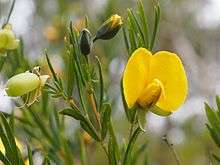Gompholobium latifolium
Gompholobium latifolium, commonly known as golden glory pea or broad-leaved wedge-pea, is a plant in the pea family Fabaceae and is endemic to eastern Australia. It is a small shrub with leaves composed of three leaflets and which has relatively large yellow flowers in spring and early summer.
| Golden glory pea | |
|---|---|
 | |
| Gompholobium latifolium leaves and flowers | |
| Scientific classification | |
| Kingdom: | |
| (unranked): | |
| (unranked): | |
| (unranked): | |
| Order: | |
| Family: | |
| Genus: | |
| Species: | G. latifolium |
| Binomial name | |
| Gompholobium latifolium | |
| Synonyms | |
|
Gompholobium psoraleifolium Salisb. | |
Description
Gompholobium latifolium is an erect, glabrous shrub which grows to a height of 3 m (10 ft). Its leaves are composed of three linear to lance-shaped leaflets which are mostly 25–50 millimetres (1–2 in) long and 2–6 millimetres (0.08–0.2 in) wide. The leaves have a very short stalk and are darker on the upper surface.[1][2]
The flowers are yellow and are arranged singly or in groups of up to three in leaf axils or on the ends of the branches on a stalk about 10 millimetres (0.4 in) long. The five sepals are about 12 millimetres (0.5 in) long and are only joined near their base. They are lance-shaped, dark green and glabrous on the outside and covered with flattened, matted hairs on the inside. The "standard" petal at the back of the flower is 20–30 millimetres (0.8–1 in) long and the keel is sometimes greenish but is always densely hairy along its edge with the hairs up to 1 millimetre (0.04 in) long. Flowering mostly occurs from September to November and is followed by the fruit which is an oval to roughly spherical legume up to 18 millimetres (0.7 in) long and 10 millimetres (0.4 in) wide containing twelve to fifteen brownish, kidney-shaped seeds.[1][2]
Taxonomy and naming
Gompholobium latifolium was first formally described in 1805 by James Edward Smith and the description was published in Annals of Botany.[3][4] The specific epithet (latifolium) is from the Latin words latus meaning "broad"[5]:166 and folium meaning "a leaf" [5]:466 referring to the broad leaves.[6]
Distribution and habitat
Golden glory pea grows in dry sclerophyll forest in Queensland, New South Wales and Victoria in sandy soil. It is most common in New South Wales where it is widespread along the coast and nearby ranges. It is uncommon in Victoria.[1][2]
Use in horticulture
Although a desirable species with its large yellow pea flowers, G. latifolium is uncommon in gardens. It can be propagated easily from seed but viable seeds are often hard to obtain. The seeds must be boiled or scratched before they will germinate.[6][7]
 Gompholobium latifolium garden specimen
Gompholobium latifolium garden specimen.jpg) Gompholobium latifolium in the Gibraltar Range National Park
Gompholobium latifolium in the Gibraltar Range National Park G. latifolium showing the long sepals
G. latifolium showing the long sepals
References
- Wiecek, Barbara. "Gompholobium latifolium". Royal Botanic Garden Sydney: plantnet. Retrieved 26 October 2016.
- "Gompholobium latifolium". Royal Botanic Gardens Victoria: vicflora. Retrieved 26 October 2016.
- "Gompholobium latifolium". APNI. Retrieved 26 October 2016.
- Smith, James Edward; Koenig, Carl Dietrich Eberhard (ed.); Sims, John (ed.) (1805). "Remarks on the generic Characters of the Decandrous Papilionaceous Plants of New Holland". Annals of Botany. 1 (3): 505. Retrieved 26 October 2016.CS1 maint: extra text: authors list (link)
- Brown, Roland Wilbur (1956). The Composition of Scientific Words. Washington, D.C.: Smithsonian Institution Press.
- "Gompholobium latifolium". Australian Native Plants Society Australia. Retrieved 26 October 2016.
- Payne, William. "Gompholobium: The glory peas". Australian Native Plants Society Australia. Retrieved 26 October 2016.